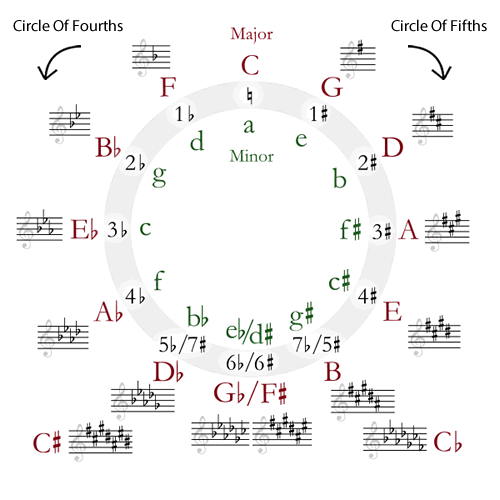Circle of Fifths
Keys, Scales, ChordsThe circle of fifths is a fundamental concept in music theory and is a handy tool for understanding the relationships between keys and their corresponding scales and chords.
It's given this name because it arranges the 12 different musical keys in a circle, with each key positioned a perfect fifth apart from the next. Remember that a perfect 5th consists of seven half steps or semi-tones. Here's how it works:
Relationship between Keys and Scales

- Key Signatures: The circle of fifths begins with the key of C major at the top. The C major scale has no sharps or flats in its key signature, so it's considered the simplest key. As you move clockwise around the circle, you add sharps to the key signature, and as you move counterclockwise, you add flats.
- Fifths: Moving clockwise, each key adds a perfect fifth (7 half-steps) to the previous one. For example:
- From C major, you move to G major, which has one sharp (F#). The notes in the G major scale are G, A, B, C, D, E, F#.
- From G major, you move to D major, which has two sharps (F#, C#). The notes in the D major scale are D, E, F#, G, A, B C#
- Relative Minor Keys: On the circle of fifths, the relative minor key is located inside the major key, on the inner part of the circle. For example, the relative minor of C major is A minor, and the relative minor of G major is E minor. The relationship between a major key and its relative minor is that they share the same key signature.
- Modulating to Related Keys: The circle of fifths helps musicians identify and transition to closely related keys. For example, to modulate from C major to G major, you move clockwise one step on the circle. This transition is smooth because the keys are closely related.
- Tonicization: Musicians use the circle of fifths to tonicize chords, briefly treating them as if they were the tonic (I) in the progression. For instance, before moving to a new key, you might tonicize the dominant chord (V) in the new key to create a temporary sense of resolution.
- Key Changes and Circle Progressions: In many songs, you'll find chord progressions that move around the circle of fifths. For example, the ii-V-I progression is a common jazz sequence that often moves through the circle. Starting in C major (I), it would go to D minor (ii), G major (V), and then back to C major (I).
Many popular songs utilize the I-IV-V progression: C Major → F Major (IV) → G major (V), and then back to C Major (I).
Circle Progressions utilize the Circle Of Fifths whereby adjacent root notes have an ascending - descending relationship. This method uses all 7 chords in a Diatonic Scale and is the most common and the strongest of all harmonic progressions. - Order of Keys: The order of keys on the circle of fifths is as follows: C major → G major → D major → A major → E major → B major → F# major → Db major → Ab major → Eb major → Bb major → F major → C major (back to the beginning).
- Practical Use: The circle of fifths is a valuable tool for musicians and composers when writing music, transposing songs, or understanding the relationships between keys and chords. It can also help you with understanding key signatures and developing a deeper knowledge of music theory.
Within the circle of fifths, at any given point, you can observe both a Major Key and its corresponding relative Minor Key, each sharing the same key signature. This key signature notates the number of sharps and flats and represents their placement on the music staff... it doesn't get much better than that. ![]()
Common Musical Intervals
To provide a quick reference, here are some common musical intervals and their corresponding half steps or semitones:
- Perfect Unison: 0 half steps (the same note)
- Minor Second: 1 half step
- Major Second: 2 half steps
- Minor Third: 3 half steps
- Major Third: 4 half steps
- Perfect Fourth: 5 half steps
- Augmented Fourth (or Tritone): 6 half steps
- Perfect Fifth: 7 half steps
- Minor Sixth: 8 half steps
- Major Sixth: 9 half steps
- Minor Seventh: 10 half steps
- Major Seventh: 11 half steps
- Perfect Octave: 12 half steps
Counterclockwise - Perfect Fourths
The perfect fifth relates to clockwise movement around the circle. If we decide to move counter-clockwise around the circle, it becomes a circle of fourths where we add a perfect 4th to each interval which spans 5 half-steps or semitones. For example:- From C major, you move to F major, which has one flat (Bb). The notes in the F major scale are F, G, A , Bb, C, D, E.
- From F major, you move to Bb major, which has two flats (Bb, Eb). The notes in the Bb major scale are Bb, C, D, Eb, G, A.
The reason counterclockwise around the circle of fifths is a perfect fourth is that the circle of fifths is a circle of perfect fifths, and the inverse of a perfect fifth is a perfect fourth.
A perfect 5th and a perfect 4th consist of 12 half-steps or semitones which make up the entire octave.
